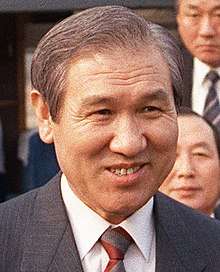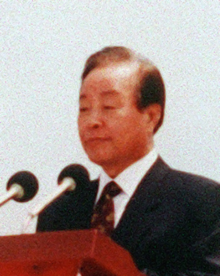1987 South Korean presidential election
Presidential elections were held in South Korea on 16 December 1987.[1] They led to the democratization of the country and the establishment of the Sixth Republic under Roh Tae-woo, ending the military dictatorship that had ruled the country since 1961. The elections took place following a series of protests and before the 1988 Summer Olympics, which would be held in Seoul.[2] Roh won the elections with 37% of the vote; voter turnout was 89.2%.
| |||||||||||||||||||||||||||||||||||||
| |||||||||||||||||||||||||||||||||||||
 Results by province and city ■ – Roh Tae-woo | |||||||||||||||||||||||||||||||||||||
| |||||||||||||||||||||||||||||||||||||
Background
The election was held following a series nationwide of protests for free and fair election and civil liberties. This period from 10 June to 29 June became known as the June Struggle,[3] and protestors was successful in persuading the regime of then President Chun Du-Hwan, and his designated successor Roh Tae Woo to accede to key demands and create the 9th amendment of the constitution.[4]
Process of constitutional revision
Under the presidency of Chun Du-Hwan, the constitution was rewritten to maintain his power and restrict the presidency to a single seven-year term, and legislation such as the Basic Press Law, which closed hundreds of media organizations, was passed.[4] However, following the success of the opposition New Korea and Democratic Party (NKDP) in the National Assembly election on 12 April 1985, calls were made for constitutional revision. On 13 April 1986, Chun made a speech defending the current version of the constitution, in which he stated that the successor to the presidency would be a member of his own party, the Democratic Justice Party (DJP), and that any discussion of constitutional debate would be put off until the end of the 1988 Olympics in South Korea.[4] In its argument, the DJP argued that the opposition was splintered, and could not act as a negotiating partner. They believed that political uncertainty would injure both the Olympic setup and the upcoming election.[5]
Nearly a month later on 10 June, mass protests broke out as Roh Tae Woo was announced successor to the presidency as the then chair of the DJP.[3] The public nature of the announcement and the death of a university student who was tortured by the police triggered protests across Korea.[3] In the following weeks, multiple protests were held, and on 29 June, the DJP candidate Roh Tae Woo capitulated to demands for constitutional amendments, proposing an eight-point plan. It included the following concessions:
- Direct participation in upcoming presidential election for all citizens over age 20
- Freedom of candidacy and fair competition
- Amnesty for Kim Dae-jung and other political prisoners
- Protection of human dignity and promotion of basic human rights
- Freedom of the press and abolishment of the restrictive Basic Press Law (see: Media of South Korea)
- Educational autonomy and local self-government
- The creation of a new political climate for dialogue and compromise
- Commitment to enact bold social reforms to build a clean, honest, and more just society.
The new constitutional amendment was ratified by the National Assembly on 12 October, and was submitted to a referendum to the South Korean public on 27 October. 93% of voters cast ballots in favor of the amendment, which permitted the direct, democratic election of the 6th President of South Korea.[4]
Presidential nominations
Democratic Justice Party
The Democratic Justice Party (DJP) National Convention was held on 10 June at Jamsil Gymnasium in Seoul.. At the convention, 7,378 delegates nominated former Commander of Capital Defense Roh Tae-woo, who was the only option on the ballot paper, for president.[6]
New Democratic Republican Party
The New Democratic Republican Party (NDRP) National Convention was held on 30 October at Heungsadan Hall in Seoul. Kim Jong-pil, former prime minister and former five-term lawmaker from South Chungcheong, was chosen as the party's candidate.[7]
Reunification Democratic Party
The Reunification Democratic Party (RDP) National Convention was held on 9 November at Sejong Center for Performing Arts in Seoul. Kim Young-sam, a former seven-term lawmaker from Busan, was nominated for president by the acclamation of 1,203 delegates.[8]
Peace Democratic Party
The Peace Democratic Party (PDP) National Convention was held on 12 November at Sejong Center for Performing Arts in Seoul. Kim Dae-jung, a former four-term lawmaker from South Jeolla and 1971 presidential candidate, was nominated for president.[9]
Results
| Candidate | Party | Votes | % | |
|---|---|---|---|---|
| Roh Tae-woo | Democratic Justice Party | 8,282,738 | 36.6 | |
| Kim Young-sam | Reunification Democratic Party | 6,337,581 | 28.0 | |
| Kim Dae-jung | Peace Democratic Party | 6,113,375 | 27.0 | |
| Kim Jong-pil | New Democratic Republican Party | 1,823,067 | 8.1 | |
| Shin Jeong-yil | Unified Korea Party | 46,650 | 0.2 | |
| Total (Turnout: 89.2%) | 23,066,419 | 100.0 | ||
| Source: Nohlen et al | ||||
By province
| provinces · cities |  |
 |
.jpg) |
 | ||||
|---|---|---|---|---|---|---|---|---|
| Roh Tae-woo DJP |
Kim Young-sam RDP |
Kim Dae-jung PDP |
Kim Jong-pil NDRP | |||||
| Votes | % | Votes | % | Votes | % | Votes | % | |
| Seoul | 1,682,824 | 30.3% | 1,637,347 | 29.1% | 1,833,010 | 32.6% | 460,988 | 8.2% |
| Busan | 640,622 | 32.1% | 1,117,011 | 56.0% | 182,409 | 9.1% | 51,663 | 2.6% |
| Daegu | 800,363 | 70.7% | 274,880 | 24.3% | 29,831 | 2.6% | 23,230 | 2.1% |
| Incheon | 326,186 | 39.4% | 248,604 | 30.0% | 176,611 | 21.3% | 76,333 | 9.2% |
| Gwangju | 22,943 | 4.8% | 2,471 | 0.5% | 449,554 | 94.4% | 1,111 | 0.2% |
| Gyeonggi | 1,204,235 | 41.4% | 800,274 | 27.5% | 647,934 | 22.3% | 247,259 | 8.5% |
| Gangwon | 456,596 | 59.3% | 240,585 | 26.1% | 81,478 | 8.8% | 49,954 | 5.4% |
| Chungcheongbuk | 355,222 | 46.9% | 213,851 | 28.2% | 83,132 | 11.0% | 102,456 | 13.5% |
| Chungcheongnam | 402,491 | 26.2% | 246,527 | 16.1% | 190,772 | 12.4% | 691,214 | 45.0% |
| Jeollabuk | 160,760 | 14.1% | 17,130 | 1.5% | 948,955 | 83.5% | 8,629 | 0.8% |
| Jeollanam | 119,229 | 8.2% | 16,826 | 1.2% | 1,317,990 | 90.3% | 4,831 | 0.3% |
| Gyeongsangbuk | 1,108,035 | 66.4% | 470,189 | 28.2% | 39,756 | 2.4% | 43,227 | 2.6% |
| Gyeongsangnam | 792,757 | 41.2% | 987,042 | 51.3% | 86,804 | 4.5% | 51,242 | 2.7% |
| Jeju | 120,502 | 49.8% | 64,844 | 26.8% | 45,139 | 18.6% | 10,930 | 4.5% |
Allegations of election manipulation
According to American Central Intelligence Agency (CIA) documents obtained by Hong Kong's South China Morning Post through a freedom of information request in July 2019, the military-backed ruling forces feared the loss of its hand-picked candidate Roh Tae-woo that it drew up detailed plans to fix the election result. The CIA briefing added that a “plan for extensive fraud is already being implemented”.
The brief added that the government was "considering black propaganda and dirty tricks, reportedly to include ballot tampering; some officials now appear prepared to go even further" and “ruling-camp planners have thought about fabricating evidence of ruling-party fraud to give Chun an opportunity to declare the election null and void if government projections from early returns indicate Roh is losing”.
The documents suggested that the government was prepared to crack down hard on any unrest following the vote, with an Intel briefing stating that an “open arrest order” had been prepared for opposition candidate Kim Dae-jung if he tried to “instigate a popular revolt against the election results”. [10]
Reaction
According to Lynn Turk, at the time a Seoul-based US State Department foreign service officer who watched the campaign and the election closely on a moment-to-moment basis noted the allegations as “a very interesting story”, but stated “the votes were counted fairly and Roh really did win fair and square.” She added: “On election night each of the four parties had observers at each polling place and got a carbon copy of the public hand-counted vote. So the totals their command posts registered matched the official count.”[11]
Park Chul-un, brother-in-law and aide to Roh Tae-woo, said ‘no election fraud was planned or carried out’ in the 1987 election in response to the SCMP report.[12]
References
- Dieter Nohlen, Florian Grotz & Christof Hartmann (2001) Elections in Asia: A data handbook, Volume II, p420 ISBN 0-19-924959-8
- Hyde, Georgie D.M. (1988-01-01). South Korea : education, culture, and economy. St. Martin's Press. ISBN 0312016662. OCLC 17386117.
- Armstrong, Charles K. (2003-01-01). Korean society : civil society, democracy, and the state. Routledge. ISBN 0415263875. OCLC 52996563.
- Sun-Chul, Kim (2016-01-01). Democratization and social movements in South Korea : defiant institutionalization. Routledge. ISBN 9780415582582. OCLC 974834381.
- Haberman, Clyde (1987-04-14). "SOUTH KOREA STEPS UP ITS ATTACKS ON OPPOSITION". The New York Times. ISSN 0362-4331. Retrieved 2017-04-29.
- 강성구. "[6.10 민정당전당대회]전당대회 및 대통령후보 지명대회[강성구]". imnews.imbc.com (in Korean). Retrieved 2018-04-24.
- 강성구. "[13대 대선]신민주공화당 중앙당 창당 대회[김형민]". imnews.imbc.com (in Korean). Retrieved 2018-04-24.
- 강성구. "[13대 대선]민주당 임시전당대회,김영삼총재 후보 공식 추대[박석태]". imnews.imbc.com (in Korean). Retrieved 2018-04-24.
- 손석희. "평화민주당 창당대회, 대통령후보 추대 전당 대회[정성환]". imnews.imbc.com (in Korean). Retrieved 2018-04-24.
- Power, John (2019-07-20). "Secret CIA files reveal plans for meddling in South Korea's first democratic election". South China Morning Post. Retrieved 2019-07-20.
- Martin, Bradley K. (2019-07-21). "South Korean generals 'considered' cheating in 1987 election". Asia Times. Retrieved 2019-11-11.
- Chan-kyong, Park (2019-07-22). "In South Korea, No 2 to former president Roh dismisses 'dirty tricks' in CIA files as groundless". South China Morning Post. Retrieved 2019-11-11.
.png)